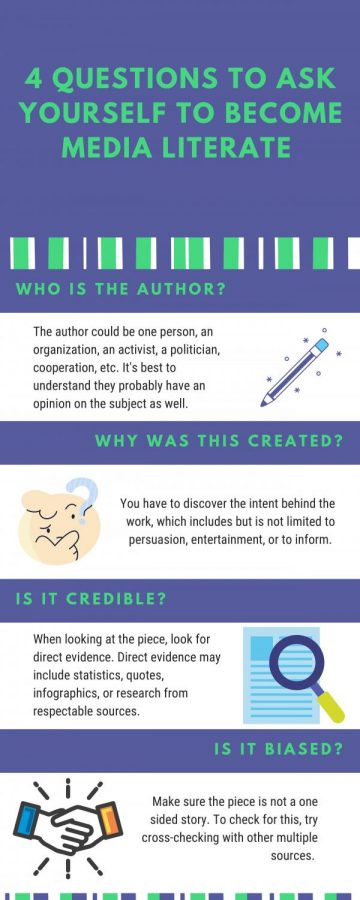Is Today’s News Reliable?
March 2, 2021
Senior Brody Grasher (’21) designed and presented a project for his AP seminar class. “I’ve been really intrigued by Social Networking Sites and their role in the news, and I especially think it’s important to understand the type of influence that they have considering many view it as the new public forum for debate,” Grasher said.
His project displays where teens receive their news. His goal was to find out whether teens use traditional sources (cable news shows, papers, etc.) versus modern sources (SNS – Social Networking Sites) for news.
“Over the past few months, I have been going to different SNS to see how the information is presented to the viewer.” To gather his information, Grasher surveyed the student body. “My prediction was that results regarding use would be slanted towards SNS, more specifically, Twitter,” Grasher revealed. Unfortunately, he was unable to disclose the results of the survey
To his surprise, “Studies have shown that confidence in the media has dropped significantly and that lack of trust has provided an alley for SNS where users can locate and identify information and engage in social discourse.”
When specifically asked whether he’d surveyed teens viewing news on TikTok, Grasher revealed, “When I was getting ready to send out the survey, there were strong rumors that it was going to get banned after being accused by the previous administration of leaking private data of Americans to the Chinese government.” After further investigation and decision making, “In the end, the unpredictability of the site’s future ended up not making the final survey draft. The timing was unfortunate.”
As for Grasher’s own opinion, “ I love reading the print Wall Street Journal, but my schedule has been getting super busy, so I’ve been resorting to online websites as of late for up to date news.”
He explained, “I really enjoy newspapers because it does a terrific job separating news from analysis.”
With today’s events Grasher believes, “There are good journalists out there seeking the truth but as I just mentioned, there are people that have alternative agendas to make more money or advance a particular political cause.”
“I believe that the information we are consuming will be in the halls of Congress one day which is why it’s paramount that I research this. In essence, SNS in my view is the public forum of the 21st century,” Grasher voiced.
From Albaugh’s Media Literacy Experiment
Upon scrolling through Tik Tok I was drawn to these two videos because of the extreme difference of opinions shown. The first video explains how, contrary to child birth, nobody knows the pain a baby feels when an abortion is performed. The second video is a rebuttal to the first stating that the fetus does not feel any pain. Upon seeing the difference in information given to me I decided to fact check both videos.
In the first video the man does not state where he got his information or who he is to know such information, that a baby does feel pain during an abortion. However, in the second video the girl states that she is a neuroscientist and got her information from literature, experiments, and research over the years from her line of work.
After evaluating this information I decided to bring in a third source from a medical website. The website that I decided to use belonged to the Massachusetts General Hospital and Harvard Medical Teaching School Hospital. After researching the website I found that they are a center for Law, Brain, and Behavior.
They put new and accurate neuroscience in the hands of judges, lawyers, policymakers, and journalists. After learning this about the website I concluded that they were a credible and reliable source.
I then found an article from the Huffington Post that they posted discussing the matter of, does a fetus feel pain during an abortion? They started by explaining what pain is, they stated that “pain has two necessary elements: an unpleasant stimulus and an emotional response to it.” They later stated that neither is possible in a fetus. They also state that “Although nerves from the periphery reach the spinal cord of an embryo early in development, they only reach the brain late in pregnancy.” Meaning that a baby may respond to touch the same way an earthworm or insect would, however, it is only a reflex, and the wiring carrying stimuli that cause the baby to actually feel pain doesn’t reach the brain until after the time when an abortion is legal.
In conclusion, after contrasting this new found information with the information stated within the two Tik Toks I can see that the information given by the girl in the second video is most accurate.
Corporate News On Tik Tok
Teens aren’t the only ones spreading news on Tik Tok. Many popular news organizations have taken the opportunity to use the popular platform of Tik Tok to spread credible news throughout the app. Tik Tok has become another source of news for these companies such as, CBS, Yahoo, NBC, and The Washington Post.
Political and world news is not the only news being spread on Tik Tok; celebrity life is heavily documented on the app along with events within pop culture. This news is documented on accounts such as E News and Hollywood Life. Tik Tok has proven itself to be a new platform for corporations to spread their influence amongst the younger population.







